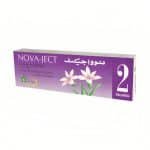delivery within 72 Hours
Safeload Device
₨ 257
Product Title: Safeload Device
Generic: intrauterine contraceptive device
Pack Size: 1’S
Product Form: Device
Delivery within: Delivery within 2 to 3 working days Across Pakistan
Shipping & Delivery
-
Courier delivery
Our courier will deliver to the specified address
2-3 Days
From Rs 250
-
Free 15-Day returns

Black Friday Blowout!
Description
Safeload Device is an intrauterine contraceptive device (IUD) designed to provide long-term contraception for women. It is a small, T-shaped device made of flexible plastic or copper that is inserted into the uterus by a healthcare provider. The Safeload Device is highly effective at preventing pregnancy and offers a convenient and reversible form of birth control.
Key Features:
- T-Shaped Design: The Safeload Device is shaped like a “T” to fit securely within the uterus, where it prevents pregnancy by interfering with sperm movement and fertilization.
- Hormone-Free Option: Some models of the Safeload Device are hormone-free, relying on the presence of copper to create an inhospitable environment for sperm, while others may release small amounts of hormones to further prevent pregnancy.
- Long-Lasting: Once inserted, the Safeload Device provides continuous contraception for several years, depending on the specific model used. It does not require daily or weekly maintenance, offering women a convenient and hassle-free birth control option.
- Reversible: The Safeload Device can be removed at any time by a healthcare provider, allowing women to quickly regain fertility if they decide to become pregnant or switch to a different method of contraception.
How it Works:
The Safeload Device works by preventing sperm from reaching and fertilizing an egg. In hormone-free models, the copper on the device creates an environment within the uterus that is toxic to sperm, inhibiting their movement and ability to fertilize an egg. In models that release hormones, such as levonorgestrel, the hormones thicken cervical mucus, making it more difficult for sperm to enter the uterus and reach an egg, and may also prevent ovulation in some cases.
Benefits:
- Highly effective at preventing pregnancy
- Long-lasting contraception with one-time insertion
- Hormone-free option available
- Reversible and quickly reversible upon removal
- Does not interfere with sexual intercourse or spontaneity
Considerations:
- Requires insertion by a trained healthcare provider
- May cause temporary discomfort or cramping during insertion
- Some women may experience irregular bleeding or spotting, especially during the first few months after insertion
- While rare, there is a small risk of complications such as perforation of the uterus or expulsion of the device
FAQs:
- How is the Safeload Device inserted? The Safeload Device is inserted into the uterus by a trained healthcare provider during a simple office procedure. The cervix is gently dilated, and the device is placed in the uterus, where it remains in position to provide contraception.
- How long does the Safeload Device provide contraception? The Safeload Device can provide contraception for several years, depending on the specific model used. Hormone-free copper IUDs typically provide contraception for up to 10 years, while hormonal IUDs may provide contraception for 3 to 5 years.
- Can the Safeload Device be used by women who have not had children? Yes, the Safeload Device can be used by women who have not had children, although some healthcare providers may recommend other forms of contraception for women who have never been pregnant due to slightly increased risks during insertion.
- Is the Safeload Device effective immediately after insertion? The Safeload Device is typically effective immediately after insertion, although some healthcare providers may recommend using backup contraception, such as condoms, for the first week after insertion to minimize the risk of pregnancy.
- Can the Safeload Device be used while breastfeeding? Yes, the Safeload Device is safe to use while breastfeeding and does not affect breast milk production or quality. It is considered a suitable option for women who wish to avoid pregnancy while breastfeeding.
Customer Reviews
You must be logged in to post a review.







Reviews
Clear filtersThere are no reviews yet.